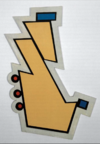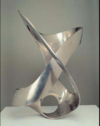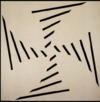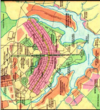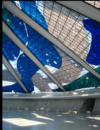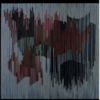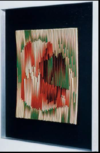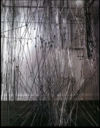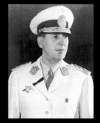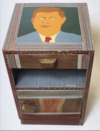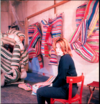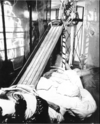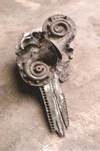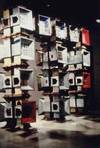Post-War Final Flashcards
(259 cards)

Cercle et Carré exhibition catalogue –April 1930
incl. Torres-Garcia
Universal Constructivism, France

Cercle et Carré exhibition catalogue –April 1930
incl. Torres-Garcia
Universal Constructivism, France
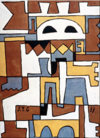
Joaquín Torres-García
Intertwined Psychic Forms
1933
Universal Constructivism, Uruguay
- 1933 starts to develop signature style and incorporate signs and symbols, is looking at ancient art (Trocadero)

Joaquín Torres-García
Constructive Composition No. 548
1932
Universal Constructivism, Uruguay
- Invoke ideas of the constructive that are hallmark of artist at this time (painterly, handmade, truth to materials, notions of the ritual and metaphysical, cosmic)
- Flo sees signs as not literal references but metaphorical

Torres-García’s
“Structures” notebooks
Paris, 1932
Universal Constructivism, Uruguay
- shows that artist is looking universally at objects from all over (Byz, Classical Greek, African, Asian, Egyptian)

Torres-García’s
“Structures” notebooks
Paris, 1932
Universal Constructivism, Uruguay
- shows that artist is looking universally at objects from all over (Byz, Classical Greek, African, Asian, Egyptian)

Joaquín Torres-García
Inverted Map
Published in Circulo y cuadrado
No. 1, May 1936
Universal Constructivism, Uruguay
- everything points to Uruguay and Montevideo, emphasizes the local sense of place

Joaquín Torres-García
Abstract Tubular Structure
1937
Universal Constructivism, Uruguay
- still grids but no pictograms, most abstract of work, contradicts most previous works

Installation of fifth exhibition of Asociación de Arte Constructivo (AAC) June 1938,
including works by Torres-García and his students
Universal Constructivism, Uruguay
- Taller doesn’t get formed until 1940s, AAC is movement before TG forms when first returns from Paris

Joaquín Torres-García
Cosmic Monument, 1938
Parque Rodo, Montevideo, Uruguay
Universal Constructivism, Uruguay
- one of first works in Montevideo, sees as realization of his art in monumental size (altho still small)
- Work based on Sun Gate in Tiahuanaco in Bolivia, a pre-civilization thought to be one of first cities; gate in Trocadero
- Top of Cosmic Monument are three figures, cube, pyramid and sphere, goes back to Mondrian
- CM becomes predecessor to other Taller productions that are larger (like hospital murals)

Joaquín Torres-García
Universal Composition
1937
Universal Constructivism, Uruguay
- Around 1940s works become busier, more black and white, less modulation in earth tones, more students work begins to look like these later paintings
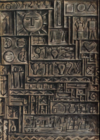
Joaquín Torres-García
Universal Art
1943
Universal Constructivism, Uruguay
- Around 1940s works become busier, more black and white, less modulation in earth tones, more students work begins to look like these later paintings

Removedor [Paint Remover]
1945-51
Torres-Garcia publication
Universal Constructivism, Uruguay
- Journal begun by students, indication of polemics of period, shows power TG still yeilded; dies in 1949 but pub. and Taller keep going (til 62)

Gonzalo Fonseca
Map of South America
1950
Universal Constructivism/ Taller Torres-Garcia, Uruguay

Gonzalo Fonseca
Cabinet
1950
Universal Constructivism/ Taller Torres Garcia, Uruguay
- Part of Taller workshops that started to expand the constructive ideas to work on windows, vases, other 3D forms

Gonzalo Fonseca
Mural
The New School for Social Research
1959-62
Universal Constructivism/ Taller Torres Garcia, Uruguay
- 66 West 12th Street

Julio Alpuy
Metaphysical Marina
1962
Universal Constructivism/ Taller Torres Garcia, Uruguay

Arturo Magazine
1st and only issue, 1944
Arden Quin, Rhod Rothfuss & Gyula Kosice
Concrete Art, Argentina
- paradox that cover AbEx but contents againt Expressionism

Arturo Magazine
1st and only issue, 1944
Arden Quin, Rhod Rothfuss & Gyula Kosice
Concrete Art, Argentina
- Invention as described by artists in against automatism, against the unconscious (surrealism)
- Orients invention towards end product rather that technique/ process

Rhod Rothfuss
[member of Arte Concrete Invencion]
Harlequin
c. 1944
Concrete Art, Argentina
- with title compares himself to Picasso and Peturutti

Tomas Maldonado
[founder of Arte Concreto-Invencion]
Untitled, 1945
Tempera on board and enamel on cardboard
Concrete Art, Argentina
- artist takes idea of irregular frame and goes with idea of center working out; opposing energies of different shapes
- Maldonado against TG and the hand-made/ primitive fascination; instead takes up rational/ scientific/ mathematical ideas of concrete art and a pure abstraction

Juan Melé
Irregular Frame, no. 2, 1946
Oil on panel
Concrete Art, Argentina
- student of Maldonado
- artist takes idea of irregular frame and goes with idea of center working out; opposing energies of different shapes

Raúl Lozza
[member of Arte Concreto-Invencion]
Relief no. 30, 1945
Oil on plywood and metal
Concrete Art, Argentina
- these objects attempt to solve problems of being sculptural, collage, doesn’t work because wall becomes illusionistic space and works become muralistic, work is rejected

Lidy Prati
[member of Arte Concreto-Invencion]
Concrete, 1945
Oil on board
Concrete Art, Argentina
- these objects attempt to solve problems of being sculptural, collage, doesn’t work because wall becomes illusionistic space and works become muralistic, work is rejected










